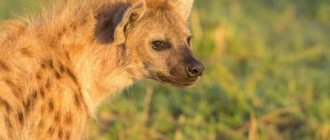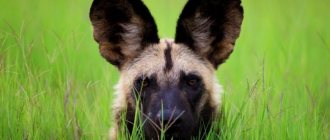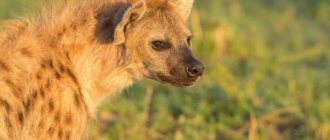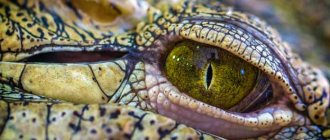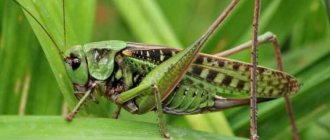№3
They are not part of the dog family, as many may think. They belong to their own family, Hyaenidae (hyenas). This family includes 4 species: the striped hyena (Hyaena hyaena) is the only species that is found outside the African continent; spotted hyena (Crocuta crocuta) - the largest representative of its family; brown hyena (Hyaena brunnea) - feeds mainly on carrion; aardwolf (Proteles cristatus) - belongs to the family of hyenas, not dogs.
Description of the spotted hyena
The spotted hyena is the largest among its relatives: its body length is about 1.3 m, its height reaches 80 cm, its skull is up to 30 cm long. The weight of adult males is in the range of 40-50 kg, for females this value is 39-51 kg . The coat is short, grayish in color, decorated with brown spots on the sides and upper legs. The fur is coarse and bristly. The head is brown, the cheeks and back of the head have a reddish tint, the tail has a black tip and brown rings along its length, the paws below are white. The color as a whole is quite variable, it can be either lighter or darker. The body is massive. The ears are round in shape. Due to the longer front legs compared to the hind legs, the animal at first glance seems clumsy and slow, but in fact such anatomical features help the hyena move as quickly as possible over long distances. In females, high testosterone levels cause the formation of false male organs.
№4
All species are social. In the case of spotted ones, they live in large groups, which often number up to 80 individuals.
Striped hyenas live in small groups. But at the same time they go hunting alone.
Browns are often found as solitary individuals, but are also capable of forming groups that rarely exceed 10 individuals.
An aardwolf can be called a loner, however, until he meets his soul mate. Typically, aardwolves live in families: a male, a female and their offspring.
Dietary features of the spotted hyena
— Advertising —
Until recently, spotted hyenas were considered typical scavengers, but research has shown that in 90% of cases they kill their victims. Hyenas hunt at a speed of about 65 km/h and are very successful. They can catch almost all animals: from small antelope to buffalo and young giraffe. Hyenas detect their victims using sight and hearing, and can pursue them at distances of up to 5 km.
Having overtaken and knocked down the victim, the spotted hyena immediately begins to eat it. The strong pressure of its powerful jaws allows the animal to gnaw the bones of its prey with ease. The rough tongue helps scrape meat off bones. Thanks to the long digestive tract, the food received by hyenas is completely absorbed.
A spotted hyena that hunts alone can kill an antelope 3 times its size, but more often these predators hunt in twos. Packs of hyenas even attack buffalos, young giraffes and baby elephants.
№6
Males and females mate outside the clan. They meet in neutral territory, where the male will court the female for several days.
Usually in one litter the female gives birth to 2 to 4 babies, who are born with their eyes already open.
Cubs begin to eat meat after about 5 months, but mothers continue to feed them milk for 12-18 months, which is a very long period for carnivores.
At approximately 2 years old, the baby becomes mature and leaves its mother.
Natural enemies of the spotted hyena
Spotted hyenas are beneficial to nature and to people. They are real orderlies of the savannas, destroying animal corpses and preventing the spread of various diseases. Today, the population size of this species has decreased compared to previous levels, but there is still no threat of its extinction.
№12
For a long time it was believed that they were hermaphrodites. All this is due to the altered genital organ of females, which is practically no different from the male. However, they are not hermaphrodites. These changes are caused by too much testosterone in the body of female hyenas.
As for the deformed genital organ, it greatly affects the life of females. Firstly, this makes it very difficult for them to mate. Secondly, childbirth for females is a real nightmare. Approximately 1 and 10 females die during childbirth. It's even worse with offspring. Most babies die from suffocation.
Facts and myths about hyenas
For a long time no one could find a kind word for the hyenas . They are treacherous and cowardly; They greedily torment carrion, laugh like demons, and also know how to change gender, becoming either females or males.
Ernest Hemingway, who traveled extensively in Africa and was well versed in the habits of animals, knew about hyenas only that they were “hermaphrodites who desecrate the dead.”
From ancient times to the present day, the same chilling stories have been told about hyenas. They were copied from book to book, but no one bothered to check them. For a long time, no one was really interested in hyenas.
It was only in 1984 that a center for studying individuals was opened at the University of Berkeley (California). Now there lives a colony of forty spotted hyenas (Crocuta crocuta), the most misunderstood animals in the world.
Who eats a lion for dinner?
In fact, spotted hyenas are very different from other predatory animals. For example, only among hyenas are females larger and more massive than males. Their constitution determines the life of the pack: matriarchy reigns here. In this feminist world, there is no point in males bickering; their life partners are much stronger and meaner than them, but they cannot be called insidious.
“Hyenas are the most caring mothers among predators,” notes Professor Stephen Glickman, who initiated the study of hyenas at Berkeley.
Unlike lionesses, hyenas drive males away from their prey, initially allowing only babies to approach it. In addition, these anxious mothers feed their cubs with milk for almost 20 months.
Many myths will be dispelled by impartial observation of hyenas. The Eaters fell? There are just no enterprising hunters who hunt down large prey with the whole flock. They eat carrion only in times of hunger.
Cowardly? Among predators, only hyenas are ready to repel the “king of beasts.” With devilish laughter, they press on the lions if they are going to take away their prey, for example, a defeated zebra, which the pack did not get easily.
Hyenas themselves attack old lions, finishing them off in a matter of minutes. A coward would only dare to attack a hare.
As for their hermaphrodism, this is one of the most common ridiculous myths. Hyenas are bisexual, although determining their gender is actually difficult. This is due to the fact that the genital organs of females are almost no different in appearance from males. Their labia form a sac-like fold, reminiscent of a scrotum; the clitoris is similar in size to the penis; only by studying its structure, one can understand that this is a female organ.
Why are hyenas so unusual? At first, Glickman and his colleagues suggested that the blood of females had a very high level of testosterone, a male sex hormone that helps form muscles and hair in males, and also encourages them to behave aggressively. However, with this hormone, everything was normal in hyenas. But in pregnant females its content suddenly increased.
The reason for the unusual structure of the hyena (the size of females and morpho-sexual similarity with males) turned out to be a hormone called androstenedione, which, under the influence of an enzyme, can be converted into the female hormone - estrogen - or the male hormone testosterone.
As Glickman found out, in pregnant hyenas androstenedione, penetrating the placenta, is converted into testosterone. In all other mammals, including humans, on the contrary, it is estrogen.
A special enzyme stimulates the appearance of estrogen, which is little active in the body of hyenas. Thus, so much testosterone is produced in the placenta that the embryo is formed with pronounced masculine (male) characteristics, regardless of gender.
Bloodthirsty kids
Due to their strange anatomy, childbirth in hyenas is very difficult and often ends in the death of the cubs. At the University of Berkeley, out of every seven cubs, only three survive; the rest die from lack of oxygen. In the wild, the mother herself often does not survive. Female hyenas most often die because they are attacked by lions during childbirth.
Striped hyena
Two and sometimes more babies are born, weighing up to two kilograms. The babies have a charming appearance: button eyes and black fluffy fur. But it’s hard to imagine more feisty little ones. A few minutes after their birth, tiny hyenas are already rushing at each other, trying to kill their brothers.
“They are the only mammals that are born with sharp canines and incisors,” Glickman notes. “In addition, unlike cats, hyenas are born sighted - and immediately see only enemies around them.”
They bite, twist, gnaw and tear at each other's backs. Their fights are in no way similar to the jostling of kittens trying to be the first to get to their mother's nipples. Hyena cubs want to be not the first, but the only one, and the struggle between them is life and death. About a quarter of the cubs die as soon as they are born.
But their passion for murderous fights gradually wears off. In the first weeks of life, the content of testosterone in the blood of young animals steadily decreases. The survivors of these feuds are reconciled with each other. It is curious that throughout their lives, female hyenas behave more aggressively than males. Why did nature turn these spotted beauties into some kind of “super mensch”?
Lawrence Frank proposed a hypothesis. Throughout their history - and it goes back 25 million years - hyenas have learned to eat prey together - as a whole pack. For kids, this kind of carcass sharing is discrimination. While the adults, pushing them aside, tore at the meat, the little hyenas were left with only scraps, mostly gnawed bones.
From such a meager diet they starved and soon died. Nature favored those females who, rushing at other hyenas, cleared a place near the prey for their babies. The more aggressive the hyena behaved, the more likely its offspring were to survive. The cubs of warlike hyenas could feast on meat along with the adults.
The ancient world about hyenas
In ancient times, two types of hyenas were known: striped and spotted, and the first, an inhabitant of North Africa and Western Asia, was, of course, more familiar to people than the spotted one, living south of the Sahara. However, ancient writers did not distinguish between the types of hyenas. Thus, Aristotle, as well as Arnobius and Cassius Felix, Latin writers, natives of Africa, mention the hyena without touching on its species differences.
Since ancient times, people have been amazed by the dexterity and perseverance with which hyenas tore up graves, so they were feared like evil demons. They were considered werewolves. A hyena seen in a dream meant a witch. In various parts of Africa it was believed that sorcerers turned into hyenas at night. Until recently, the Arabs buried the head of a killed hyena, fearing it.
In Egypt, hyenas were hated and persecuted. This “carrion eater” deeply offended the inhabitants of the Nile Valley, who were accustomed to honoring the bodies of the dead. On Theban frescoes you can see scenes of hunting with dogs for animals that lived in clearing deserts: gazelles, hares, hyenas.
The Talmud described the flow of an evil spirit from a hyena this way: “When a male hyena is seven years old, he takes the form of a bat; after another seven years it turns into another bat called arpad; after another seven years, nettles sprout; after another seven years, a thorn tree, and finally an evil spirit emerges from it.”
One of the church fathers, Jerome, who lived for a long time in Palestine, writes about it with obvious hostility, recalling how hyenas and jackals scurry in hordes on the ruins of ancient cities, instilling terror in the souls of random travelers.
Since time immemorial, there have been many different legends about hyenas. As already mentioned, they were credited with hermaphrodism and the ability to change their gender. They said with shudder that a hyena, imitating the voice of a person, lures children out and then tears them into pieces. They said that the hyena was killing dogs. The Libyans put barbed collars on their dogs to protect them from hyenas.
In Africa, the hyena can be a common pet like a dog.
Pliny wrote that the hyena looks like a cross between a dog and a wolf and will chew any object with its teeth, and immediately digests the swallowed food in its belly. In addition, Pliny gave an extensive - a whole page! - a list of potions that can be prepared from the skin, liver, brain and other organs of a hyena. Thus, the liver helped with eye diseases. Galen, Caelius, Oribasius, Alexander of Tralles, and Theodore Priscus also wrote about this.
The skin of a hyena has long been attributed magical properties. When going to sow, peasants often wrapped a basket of seeds with a piece of this skin. It was believed that this protected the crops from hail.
The author of "Motley Tales" and "On the Nature of Animals", Elian, reported that at night hyenas strangle sleeping people and devour dogs:
“On a full moon, the hyena turns its back to the light, so that its shadow falls on the dogs. Bewitched by the shadow, they become numb, unable to utter a sound; the hyenas carry them away and devour them.”
Aristotle and Pliny noted a particular dislike of hyenas for dogs. Many authors also assured that any person, be it a child, a woman or a man, easily becomes prey for a hyena if it manages to catch him sleeping.
№14
Very often they are compared to wild dogs. However, they have no relationship (as we noted earlier) and, moreover, behave differently. Wild dogs (dingoes) care about the well-being of their pack. They will share the prey so that all members of their flock are well-fed and strong. In groups of hyenas everything is somewhat different. They will fight for food, trying to satisfy only their hunger. In the case of males and females, the latter can kill the former if they create problems for them.
We also recommend reading: Interesting facts about ladybugs
Spotted hyena behavior
The lifestyle of spotted hyenas is generally similar to their relatives, but they are more dangerous and evil predators.
The howl of these animals resembles laughter. Spotted hyenas live in groups, often called clans. Everything in them is subject to a strict hierarchy. Females tend to displace males and interfere with their attempts to occupy higher positions in the group, but they do not always succeed. The struggle for power among females begins in childhood. They get into fights among themselves, which are very serious and often end in death. Weaker females die, but the stronger ones continue to assert their dominant position in the pack. But females never fight with newborns and young males. The position of young females is always lower than that of their mother. Males that have reached sexual maturity always leave for other clans.
The social status of the spotted hyena is indicated by the position of its tail: if it is raised up, then this indicates a high social status of the animal, but if it is lowered, then the status is low.
The smell of a hyena is associated with the secretion of glands that serve the animal for communication.
Population and species status
Surprisingly, in many African countries these predators are on the verge of complete extinction, which is often associated with hunting and poaching.
Important fact! Spotted hyenas are listed in the International Red Book.
In some countries, such as Botswana, the number of such mammals is regulated at the state level. Their habitat is remote from human habitations, and their status corresponds to that of ordinary game. In countries such as Malawi, Namibia, Kenya and Zimbabwe, the risk of extinction of these animals as a species is minimal.
HYENA - INTERESTING FACTS ABOUT PREDATORS OF AFRICA
Merciless baby hyenas
Hyenas have a difficult time giving birth, and this is due to their unusual anatomy. Often the cubs die at birth. At the University of California, only three out of seven cubs survived; the rest lacked oxygen. But in the wild, the mother hyena herself often dies, mainly from an attack by lions during childbirth.
Hyenas usually give birth to two (sometimes more) babies weighing up to 2 kilograms. They are adorable with black shaggy fur and button eyes. It turns out that they show their evil immediately after birth. After just a couple of minutes, these little ones attack one on one, trying to bite each other to death.
These are the only animals that are born with fangs and sharp incisors. Babies are born sighted, which is why they see only enemies around them. They are so nimble, they bite, tear and gnaw each other's backs. Their fights are not at all like pushing kittens who are trying to get to their mother's nipples.
Each of the hyena cubs wants to be not the first, but the main one, and the battle between the kids takes place to the end. It has been established that about 25 percent of babies die as soon as they see the light. Over time, the content of hormones in the blood of little hyenas decreases, and contractions between the kids subside.
The surviving cubs are reconciled and arrange relationships with each other. Interestingly, female hyenas are always much more hostile than males. So why did nature make these beautiful animals some kind of “super mensch”? It turns out there is a hypothesis here too.
And it consists in the fact that throughout their long history (this is approximately 25 million years), hyenas ate food together - in a pack. This division was not suitable for children, as they were left with scraps and gnawed bones. From such a meager feast, the kids starved and quickly died.
